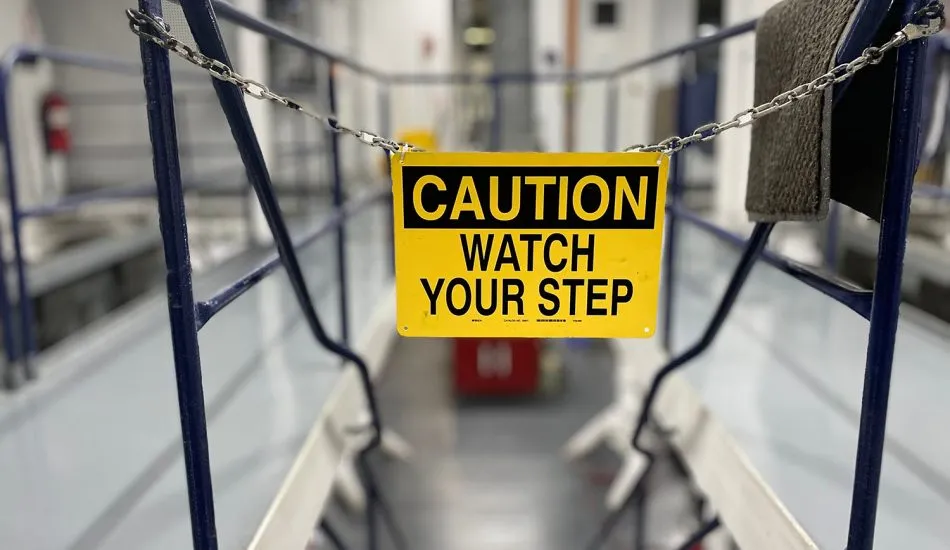Seek medical attention immediately. Report the accident to the property owner. Reach out to a personal injury attorney so you can learn more about your legal options.
Slip and Fall Prevention: Tips for Property Owners and Businesses

Did you know that among the 8 million injuries and deaths that occur each year in the United States, an estimated one-eighth are due to slip-and-fall accidents? Not only is slip-and-fall prevention a matter of safety, but property owners and businesses must be proactive about these initiatives to manage liability.
If you have been injured by a slip and fall, or you are being sued because of an accident that occurred on your property, then the most important thing you can do is call a personal injury lawyer without delay. You need legal assistance to ensure there is a favorable outcome for your case.
Common Hazards that Cause Slip and Fall Accidents
The first step in risk management is identifying the most common fall hazards on your property. Here are some of the reasons why slip and fall injuries often occur:
- Slippery or Wet Surfaces: Rain, snow, or ice outside could create hazardous conditions that result in someone falling. This risk can migrate inside when people are tracking the rain and snow into the building and the water is accumulating on the floors. Other causes of wet surfaces include recently mopped floors, spills, or polished floors.
- Damaged or Uneven Surfaces: One example of this type of fall hazard is if the sidewalk is cracked and it causes someone to stumble while they are walking. Indoor hazards might include torn mats or carpeting, unsecured rugs, or potholes in the parking lot.
- Clutter and Obstacles: Anything in the way when someone is walking could turn into a slip and fall hazard. Examples include debris or boxes on the ground, loose cords, or merchandise displays.
- Poor Lighting: It’s important to make sure that all areas are well-lit to prevent accidents. If lightbulbs are burned out or the walkways are dimly lit, then the property owner could be held liable for any accidents that result from the poor lighting.
- Other Hazards:A variety of other things could also be categorized as slip and fall accidents, such as steps and curbs (unmarked changes in elevation), overgrown landscaping, loose handrails, etc.
How to Prevent Accident Injuries on Your Property
While it might seem impossible to eliminate all hazards on your property, a proactive approach can go a long way toward reducing the risk of accidental injuries. Remember that you always have premises liability, so it’s essential to be proactive about workplace safety on commercial properties.
Here are a few tips to help you get started:
- Routine Inspections: Set up a routine inspection checklist to look over both the interior and exterior areas of your property. The goal is to identify any potential risks in the earliest stages to minimize the possibility of injury.
- Regular Maintenance: If any issues are identified during the inspection, then prompt attention is necessary. Repair or replace any surfaces that are damaged, make sure equipment is working properly, and make any other floor safety changes that might be necessary.
- Proper Cleaning: In the unfortunate event that something is spilled, the area should be marked immediately, and cleanup needs to happen as soon as possible. Make sure to always have warning signs that can be used – such as “wet floor” markers that should be out when the floor is being mopped.
- Fall Prevention Products: Invest in different products that can reduce the risk of falling. For example, it’s a good idea to put down slip-resistant mats in the high-risk areas of the building. Install guardrails and handrails for the stairs.
- Drainage and Landscaping:Outdoor areas need to be able to drain properly. If there are any landscaping issues that are causing a backup of water, then bring in a professional team to fix these problems immediately.
- Lighting Upgrades: All outdoor and indoor areas should be well-lit to prevent accidents. In addition to investing in good lighting, check the lightbulbs regularly as part of your inspection routine. One solution you might consider is adding motion sensor lighting in the areas that aren’t used frequently.
- Warnings and Signage: When you know there are potentially dangerous areas on the property, put up warning signs. The messaging needs to be clear and easy to understand – a combination of both pictures and words is best.
- Fall Safety Training: All staff members should be properly trained on slip and fall prevention. Each person needs to know how to respond to and report spills and hazards. Training for these general safety protocols ensures that all team members are proactively reducing the risk for everyone on the property.
Landlord Liability for Slip and Fall Accidents
As a property owner, you carry the responsibility to protect your team members and visitors. You need to be able to show that you are taking proactive and reasonable steps to prevent accidents on your property. You can learn more about your responsibilities by talking to a personal injury lawyer for more information.
If an injury or accident occurs, then the legal process will evaluate negligence and liability. You can take steps to reduce the likelihood that you will be found liable for the injuries based on the foreseeability of the accident (and how you prevented it), as well as your warning of the hazards.
Regardless of the size of your property or the number of people on site, always make sure that you have good liability insurance in place. You can’t prevent all accidents. But if something happens, then the insurance coverage can protect you against the financial impact of a slip and fall claim.
FAQ
Call a Personal Injury Lawyer You Can Trust
Do you need help with a personal injury claim? Then Gainsburgh, Benjamin, David, Meunier & Warshauer, L.L.C. is the team to call. Reach out at your convenience to schedule a free consultation: (504) 522-2304 .




